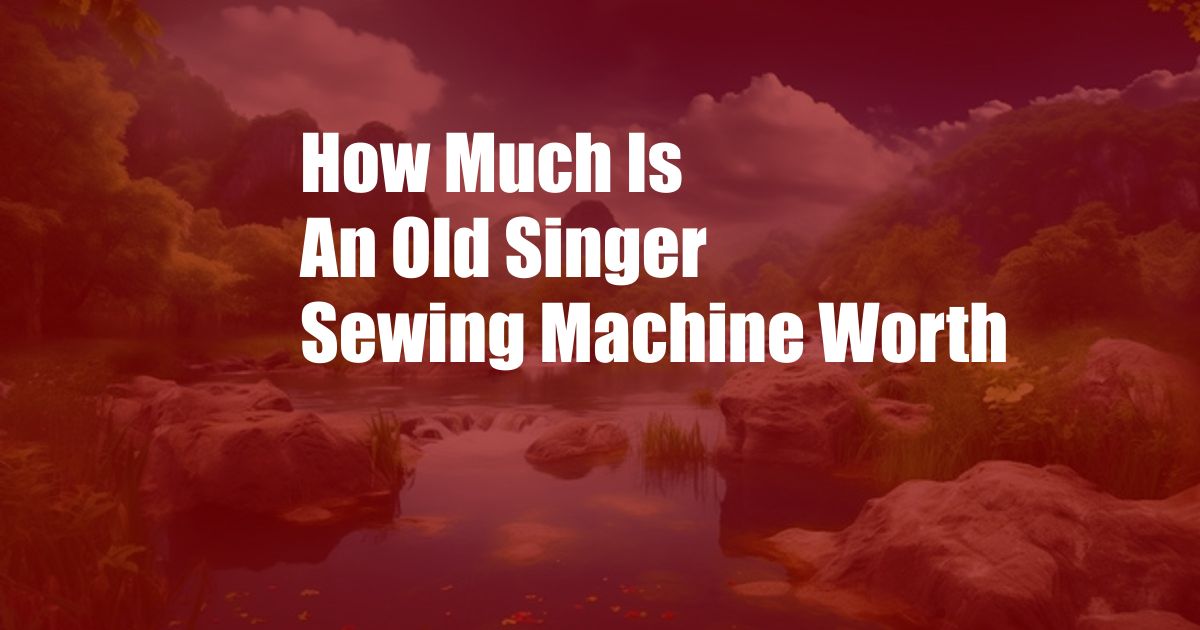
**Unlocking the Value of Vintage Singer Sewing Machines**
In the realm of heirlooms and collectibles, vintage Singer sewing machines hold a special place. From the intricate Victorian models to the sleek mid-century classics, these timeworn treasures have a captivating charm and historical significance. Discovering the value of your antique Singer machine can be a rewarding journey, unlocking both sentimental and monetary worth.
As a keen collector of vintage sewing machines, I’ve witnessed firsthand the allure and allure these relics hold. The rhythmic clatter of their treadles, the intricate patterns etched into their casings, and the tangible connection to bygone eras spark a sense of nostalgia and admiration.
**Appraising Vintage Singer Sewing Machines**
Determining the value of a vintage Singer sewing machine is not a straightforward task. Several factors contribute to its worth, including:
- Model: Different Singer models have varying values. Some rare or limited-edition machines can fetch a premium price.
- Condition: The overall condition of the machine, including its functionality, cosmetic appearance, and presence of accessories, significantly affects its value.
- Age: Older machines, particularly those produced in the 19th century, tend to be more valuable.
- Provenance: Machines with a documented history or ownership by notable figures can enhance their worth.
- Market Demand: The popularity and demand for a particular Singer model can influence its value.
**A Snapshot of the Singer Sewing Machine History**
Isaac Merritt Singer revolutionized the sewing industry with his invention of the first practical sewing machine in 1851. Over the following decades, Singer Manufacturing Company produced a vast array of models, each designed to meet specific sewing needs and cater to different markets.
Singer’s early machines, such as the vibrating shuttle machines, laid the foundation for modern home sewing. With the advent of electric motors in the early 20th century, Singer introduced models that combined ease of operation with increased speed and efficiency. The company’s Featherweight machine, released in 1933, is renowned for its portability and remains highly sought after by collectors.
**Identifying and Dating Vintage Singer Machines**
To appraise a vintage Singer sewing machine, it’s essential to correctly identify its model and determine its age. Singer machines typically have a serial number stamped on the bed or head of the machine. Using online resources or referring to vintage sewing machine identification manuals, you can cross-reference the serial number to ascertain the model and production year.
Additionally, the style and design of the machine can provide clues about its age. Victorian models, for instance, often feature ornate cast-iron bases and decorative detailing. Art Deco models from the 1920s and 1930s exhibit sleek lines and streamlined designs.
**Preserving and Maintaining Vintage Singer Machines**
Once you’ve determined the value of your vintage Singer machine, it’s crucial to preserve and maintain its worth. Proper storage in a climate-controlled environment, away from moisture and extreme temperatures, is essential. Regular cleaning and lubrication will ensure the machine remains in good working condition.
If your machine requires repairs, seek the assistance of a qualified sewing machine technician who specializes in vintage models. Using genuine Singer parts and following proper repair techniques will not only preserve the machine’s integrity but also enhance its value.
**Tips for Purchasing Vintage Singer Machines**
- Do your research: Familiarize yourself with different Singer models and their approximate values.
- Inspect the machine thoroughly: Examine the machine’s condition, test its functionality, and look for any signs of damage or repairs.
- Consider provenance: If possible, inquire about the machine’s history and any documentation available.
- Negotiate fairly: Be prepared to negotiate the price based on the machine’s condition, model, and rarity.
- Transport carefully: Use proper packaging and handling techniques to ensure the machine’s safe transport.
**Frequently Asked Questions**
- Q: How do I determine the value of my vintage Singer sewing machine?
A: Consider its model, condition, age, provenance, and market demand. - Q: How can I find a qualified technician to repair my vintage Singer machine?
A: Look for technicians who specialize in vintage sewing machines and use genuine Singer parts. - Q: How do I preserve the value of my vintage Singer machine?
A: Store it properly, clean it regularly, and use genuine Singer parts for repairs. - Q: Are all vintage Singer sewing machines valuable?
A: No, not all models are equally valuable. Rarity, condition, and desirability affect their worth.
**Conclusion**
Vintage Singer sewing machines are cherished relics that have stood the test of time. Their intrinsic beauty, historical significance, and functional value make them valuable assets. Understanding the factors that determine their worth and implementing proper care and maintenance practices will ensure these treasured heirlooms continue to grace generations to come.
Are you a collector of vintage sewing machines or simply intrigued by their history? Share your thoughts and experiences in the comments below.